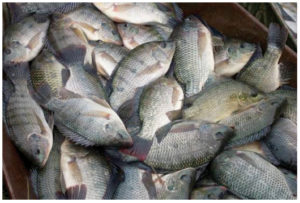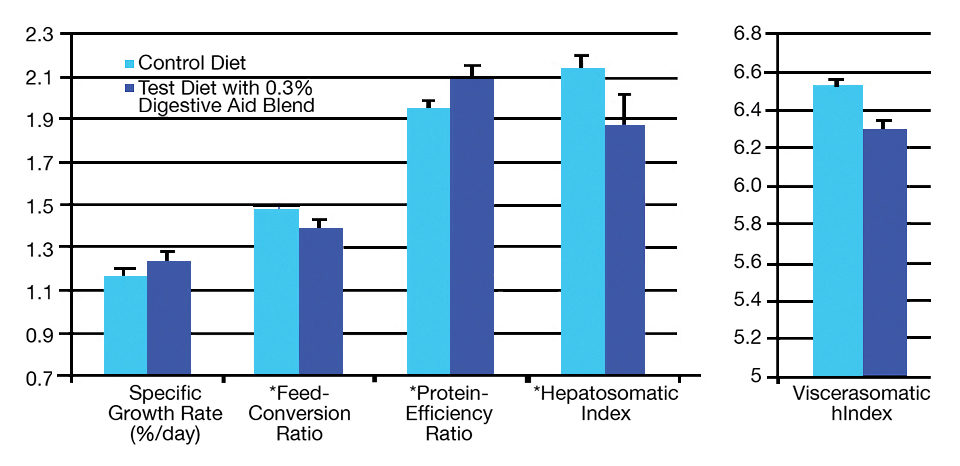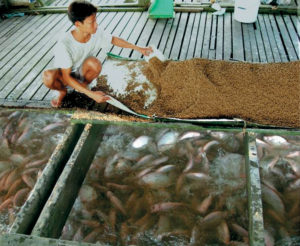Improving FCR, fillet yield important from an economical and ecological point of view

Significant price increases have occurred during the past years for major aquafeed ingredients, including fishmeal, fish oil, vegetable proteins and fats. In the livestock industry, the combined efforts of industry and academic institutes resulted in the development of a wide range of additives to improve nutrient utilization and reduce feed formulation costs.
Various types of feed additives enhance the digestibility and/or utilization efficiency of nutrients, including exogenous enzymes; stimulators of enzyme secretion; compounds that aid in the digestive process by improving absorption, mobilization and transport of nutrients; feeding stimulants that reduce feed/nutrient waste; prebiotics and probiotics; and botanical extracts that modulate gut microflora.
Some of these innovative additives show great potential for use in aquaculture, but as warm-blooded land animals have different feeding biology, digestive physiology and nutrient requirements than aquaculture species, the additives’ applications in aquaculture feed remain unclear.
Digestive phytobiotics
Recent screening work under controlled lab conditions at Caditec Testing in Spain revealed the potential of several synergistic blends of digestive phytobiotics, natural emulsifying agents and co-factors of digestion. Phytobiotics is a term used to describe plant-derived natural bioactive compounds that affect animal growth and health due to their antimicrobial, digestive metabolic-stimulating properties.
Spices, for example, are widely used to flavor human food but also exert stimulant actions on the digestive system.
Herbal digestive properties include appetite enhancement, stimulation of gastric and bile secretions, and hepato-protective properties. Emulsifying agents are a diverse class of molecules that aid in the dispersion of fat into water by forming micelles. Adding emulsifiers to diets complements lipid digestion by improving the emulsification and absorption of the dietary fats in the gut.
Laboratory trials
Through two lab trials, the authors examined the potential of such feed additives to increase growth and feed utilization in Nile tilapia. In trial 1, a practical control diet was formulated with 33 percent protein and 7.6 percent fat (Table 1). The extruded treatment diet was created by replacing 0.3 percent filler with Aquagest OMF, a mixture of digestive herbal extracts and natural emulsifying agents. For a second lab trial, three extruded diets were formulated to contain 31 percent protein and 7.5 percent fat: a practical control diet (Table 1) and two treatment diets created by replacing 0.15 and 0.3 percent filler with the digestive aid blend.
Ceulemans, Formulation of the control diets, Table 1
| Trial 1 (33% Protein/7.6% Fat) | Trial 1 (33% Protein/7.6% Fat) | Trial 2 (31% Protein/7.5% Fat) | Trial 2 (31% Protein/7.5% Fat) |
|---|
Trial 1 (33% Protein/7.6% Fat) | Trial 1 (33% Protein/7.6% Fat) | Trial 2 (31% Protein/7.5% Fat) | Trial 2 (31% Protein/7.5% Fat) |
|---|---|---|---|
| Defatted soybean meal | 30% | Defatted soybean meal | 37.51% |
| Full fat soya | 10% | Wheat bran | 24.08% |
| Whole wheat | 31.49% | Wheat flour | 8% |
| Wheat flour | 10% | Whole corn | 9% |
| Wheat gluten | 2.01% | Rapeseed | 8% |
| Corn gluten | 6% | Fishmeal | 4% |
| Fishmeal | 5% | Corn gluten | 3% |
| Fish oil | 2% | Fish oil | 2.31% |
| Dicalcium phosphate | 2% | Dicalcium phosphate | 1.86% |
| Filler | 1% | Soybean oil | 1.47% |
| Vitamine mineral mix | 0.5% | Vitamine mineral mix | 0.5% |
| Lysine (78%) | 0.12% | ||
| Methionine (99%) | 0.15% |
Both trials were executed in a recirculating system. For trial 1, 25 Oreochromis niloticus tilapia with initial weight of 38.8 ± 0.2 grams were stocked in each of three cylindrical fiberglass tanks with 100 L active volume. For trial 2, 35 tilapia weighing 9.1 ± 0.2 grams were stocked in three similar tanks.
Freshwater at 26 degrees-C was recirculated over a biofiltration unit, sand filter and protein skimmer. Water renewal was 10-15 percent/day depending on water quality. Photoperiod was set to provide 12 hours of light daily.
After a one-week acclimatization in which the control diet was fed to all tanks, feeds were fed to triplicate groups of animals for 10 weeks in trial 1 and eight weeks in trial 2. Feed rations were calculated on a percentage of body weight for both trials. Feeding was done by automatic belt feeders placed on top of the tanks. Uneaten pellets were recovered, and the feed intake was adjusted accordingly.
Ceulemans, Performance of Nile tilapia fed test diets, Table 2
| Control Diet | Test Diet With 0.15% Digestive Aid Blend | Test Diet With 0.3% Digestive Aid Blend |
|---|
Control Diet | Test Diet With 0.15% Digestive Aid Blend | Test Diet With 0.3% Digestive Aid Blend | |
|---|---|---|---|
| Survival (%) | 100 ± 0 | 100 ± 0 | 100 ± 0 |
| Initial weight (g) | 9.17 ± 0.04 | 9.15 ± 0.13 | 8.93 ± 0.21 |
| Final weight (g) | 41.84 ± 0.83 | 44.32 ± 1.25 | 44.3 ± 1.99 |
| Specific growth rate (%/day) | 2.71 ± 0.03a | 2.82 ± 0.03ab | 2.86 ± 0.08b |
| Feed intake (g/fish) | 37.86 ± 0.65 | 38.83 ± 1.18 | 38.3 ± 1.15 |
| Feed-conversion ratio | 1.16 ± 0.01a | 1.1 ± 0.01b | 1.08 ± 0.03b |
| Protein-efficiency ratio | 2.75 ± 0.03a | 2.86 ± 0.02ab | 2.92 ± 0.1b |
| Hepatosomatic index (%) | 1.6 ± 0.15 | 1.48 ± 0.11 | 1.43 ± 0.01 |
| Viscerasomatic index (%) | 8.45 ± 0.09a | 7.79 ± 0.11b | 8.41 ± 0.13a |
Results
In trial 1, survival was over 95 percent. The addition of the mix of digestibility enhancers to a practical control diet resulted in improved growth, feed utilization and protein efficiency (Figure 1). Also, the weight of the fish livers and viscera was reduced compared to the control diet.


In trial 2, supplementation of the feed with 0.15 percent digestive aid blend yielded 5 percent better feed conversion, 4 percent higher growth and 4 percent higher protein utilization. When increasing the supplementation from 0.15 to 0.3 percent, these factors were further improved. The hepatosomatic index was reduced by increasing levels of digest aid blend, amounting to a reduction of 11 percent for the 0.3 percent extract diet. The viscerasomatic index was reduced by 8 percent in the 0.15 percent-supplemented diet, but this effect disappeared in the 0.3 percent-supplemented diet. Overall, little visceral fat was found in these young animals.
The decreased hepatosomatic index indicated that more dietary energy was made available for the fish’s metabolism, resulting in more protein available for fillet growth as illustrated by the improved protein-efficiency ratio. Improving feed conversion and fillet yield while reducing visceral wastes is not only important from an economical but also from an ecological point of view.
(Editor’s Note: This article was originally published in the November/December 2009 print edition of the Global Aquaculture Advocate.)
Now that you've finished reading the article ...
… we hope you’ll consider supporting our mission to document the evolution of the global aquaculture industry and share our vast network of contributors’ expansive knowledge every week.
By becoming a Global Seafood Alliance member, you’re ensuring that all of the pre-competitive work we do through member benefits, resources and events can continue. Individual membership costs just $50 a year. GSA individual and corporate members receive complimentary access to a series of GOAL virtual events beginning in April. Join now.
Not a GSA member? Join us.
Authors
-
-
Peter Coutteau, Ph.D.
Nutriad Technology Center
Belgium -
Rocio Robles
Caditec Testing S.L.
Puerto Real, Cadiz, Spain
Related Posts

Aquafeeds
A new nutrient for aquaculture, from microbes that consume carbon waste
Biotechnology firm NovoNutrients aims to produce a line of nutraceutical aquafeed additives as well as a bulk feed ingredient that can supplement fishmeal. Its process includes feeding carbon dioxide from industrial gas to a “microbial consortium” starring hydrogen-oxidizing bacteria.

Aquafeeds
ASAIM addresses challenges to growth of marine fish farming in Southeast Asia
In its efforts to advance sustainable aquaculture practices and the use of soy-based feeds in Southeast Asia, the American Soybean Association International Marketing Program (USAIM) has identified several challenges.

Health & Welfare
Aiding gut health with a natural growth promotor
A study with Nile tilapia conducted in commercial production cages in Brazil showed the potential – in the absence of major disease threats – of a commercial, natural growth promotor that modulates the microbiota (inhibiting growth of pathogenic bacteria and promoting growth of beneficial bacteria) and inhibits quorum sensing.

Aquafeeds
Animal co-product hydrolysates sources of key molecules in aquafeeds
Key molecules found in animal byproduct hydrolysates show potential for use as functional ingredients in aquaculture feeds. Animal co-product hydrolysates from slaughterhouse waste and rendered animal byproducts present a protein alternative.


